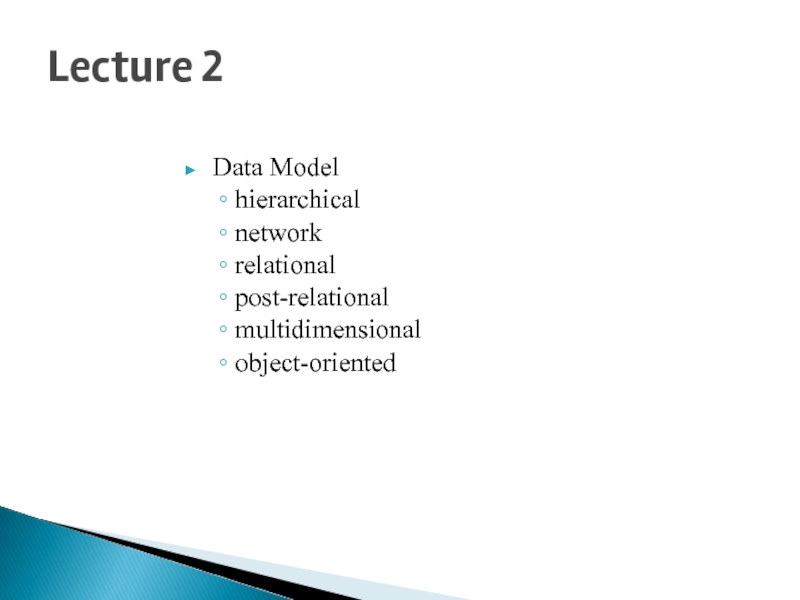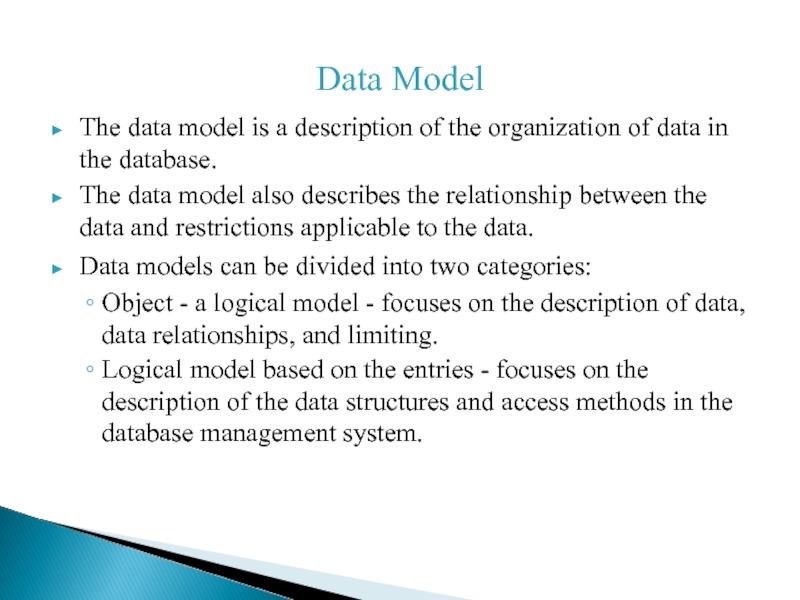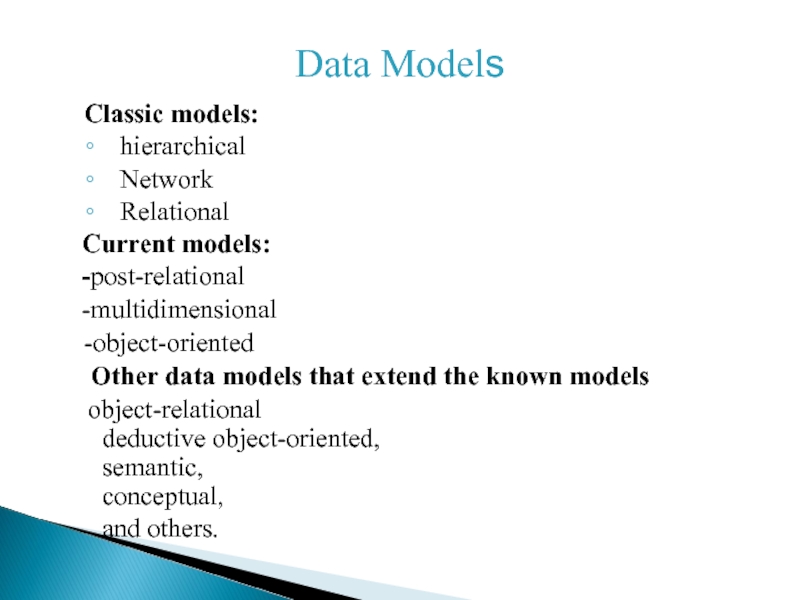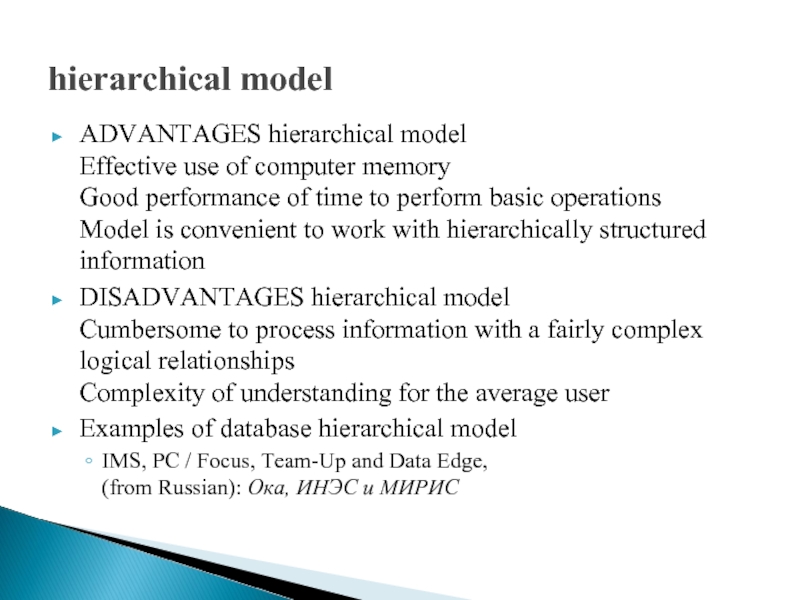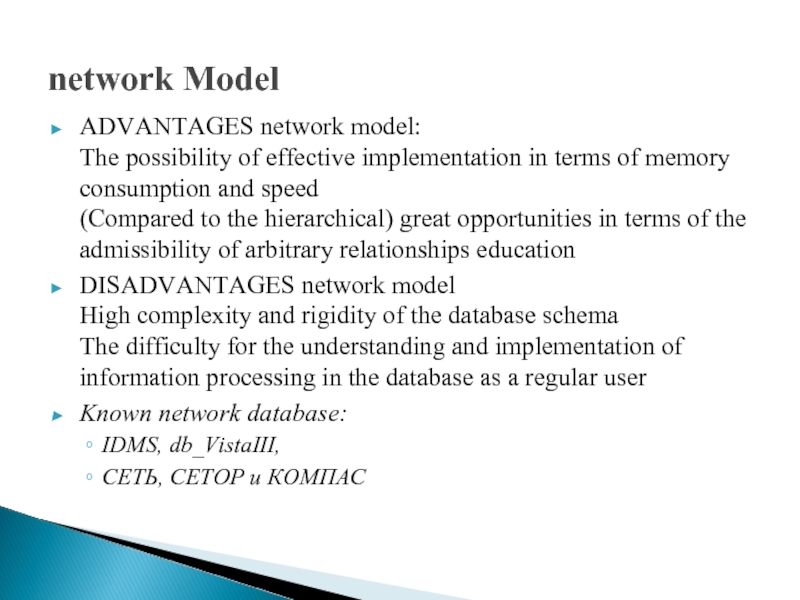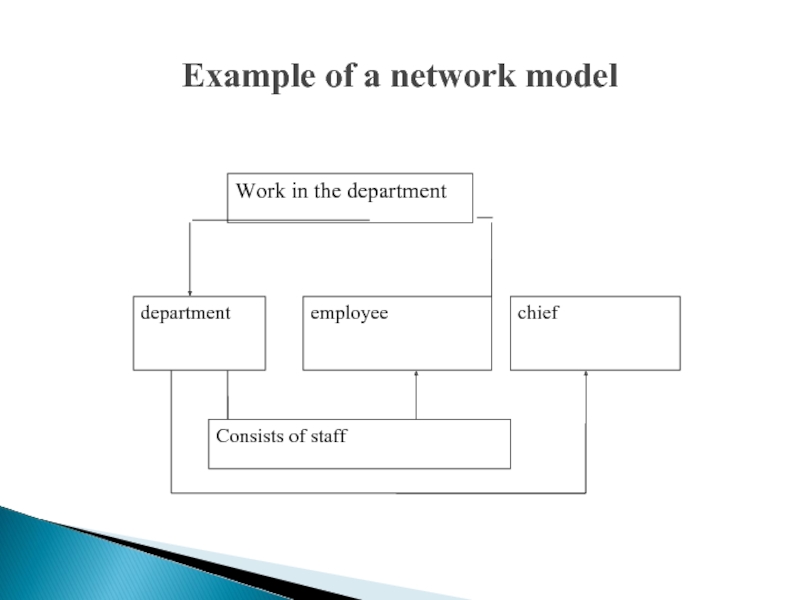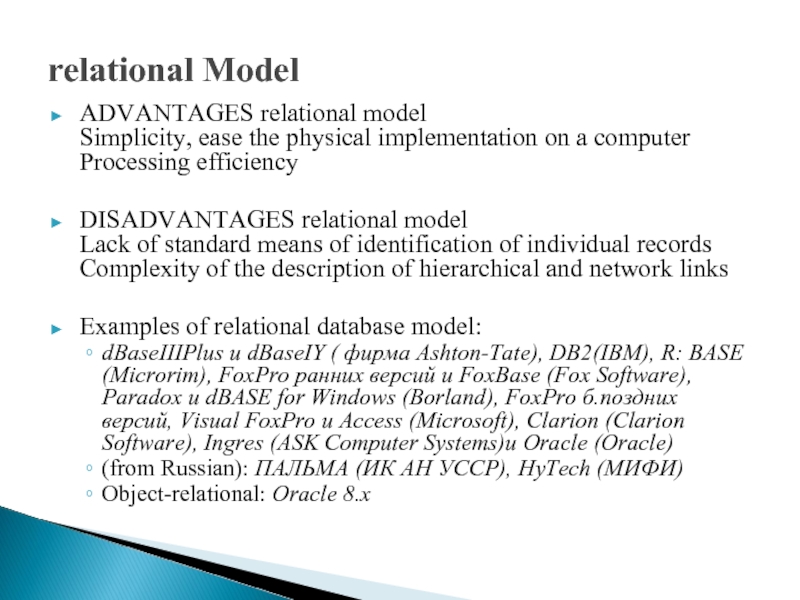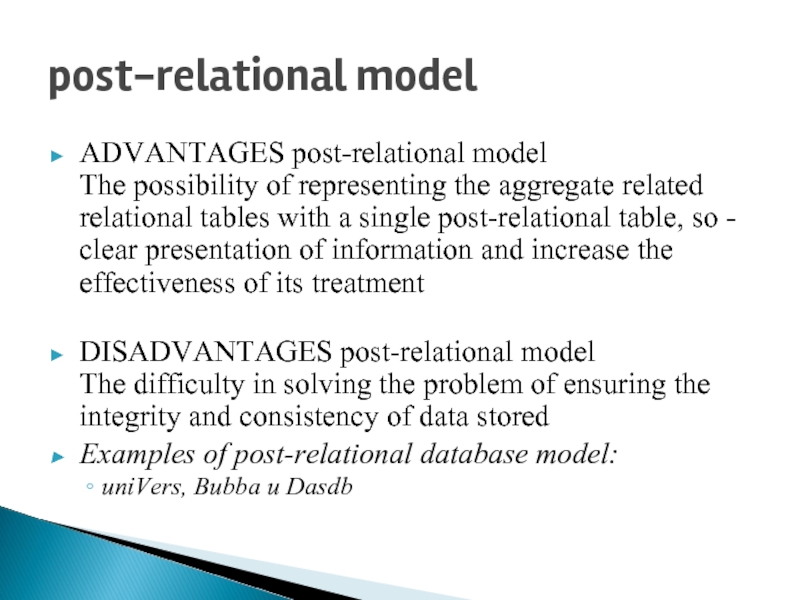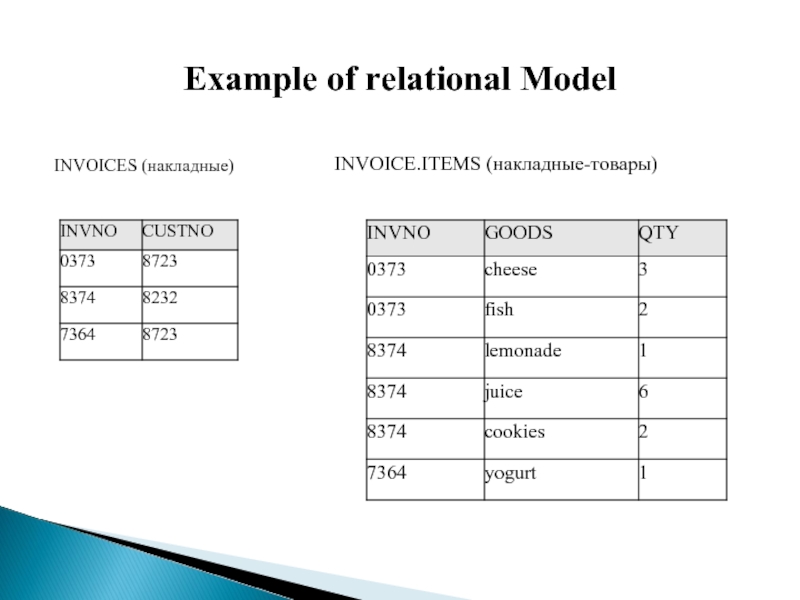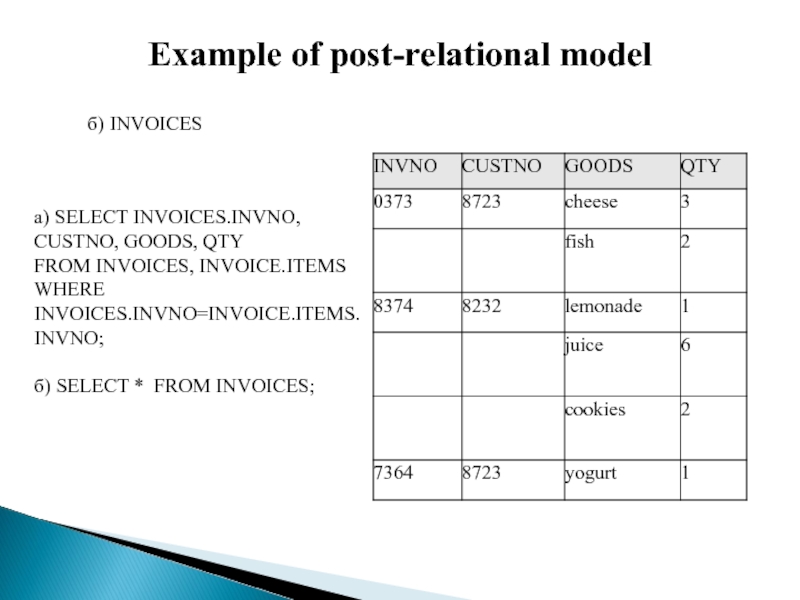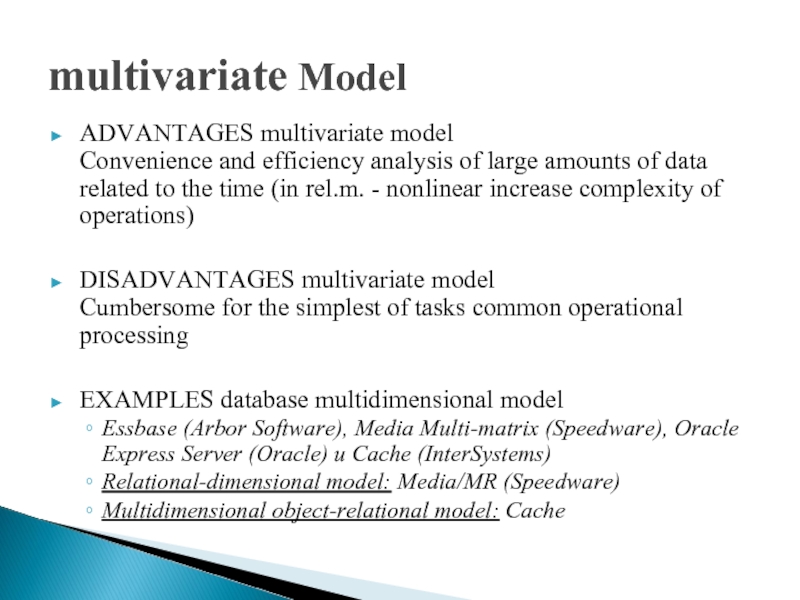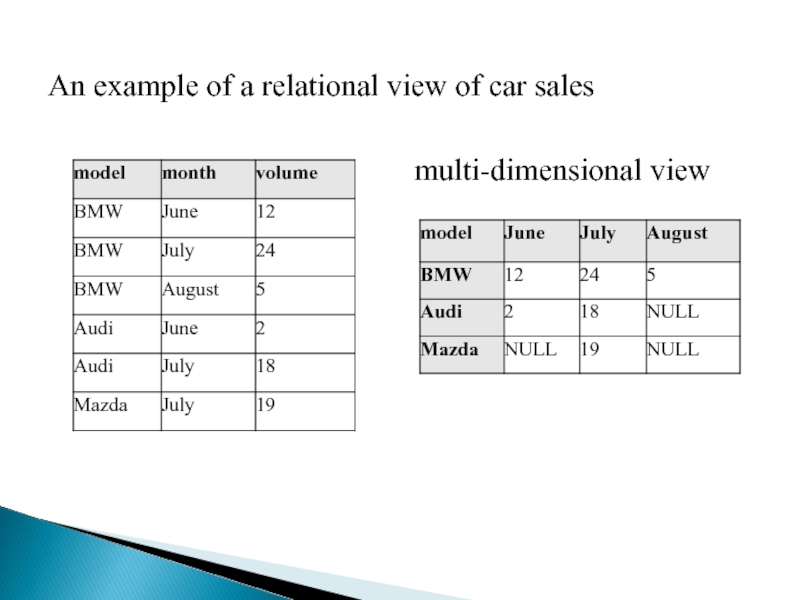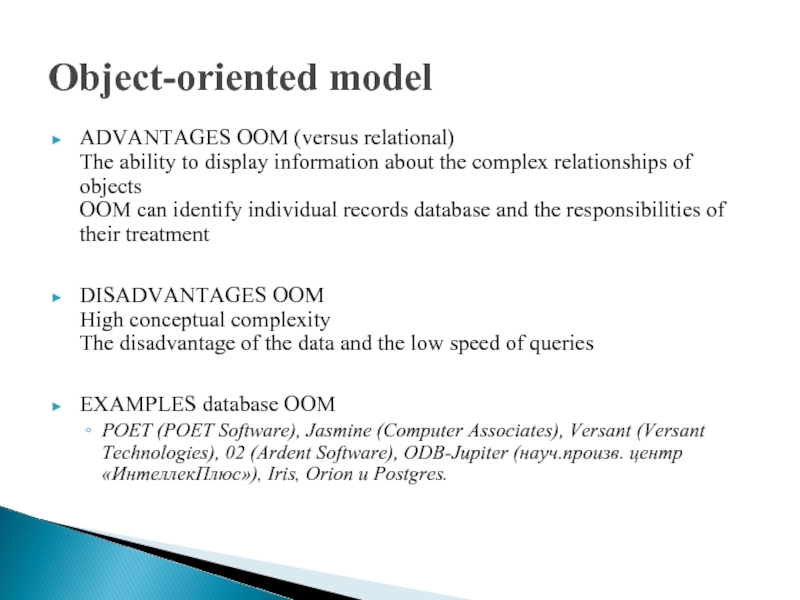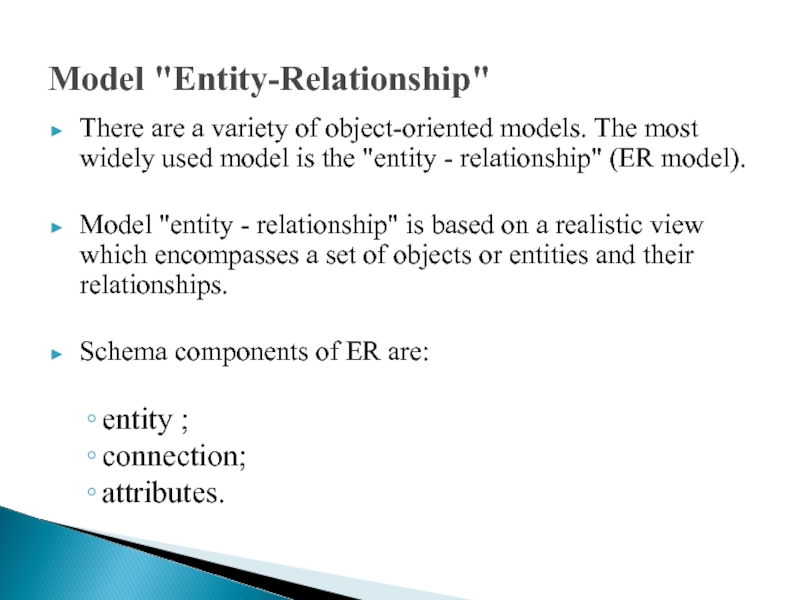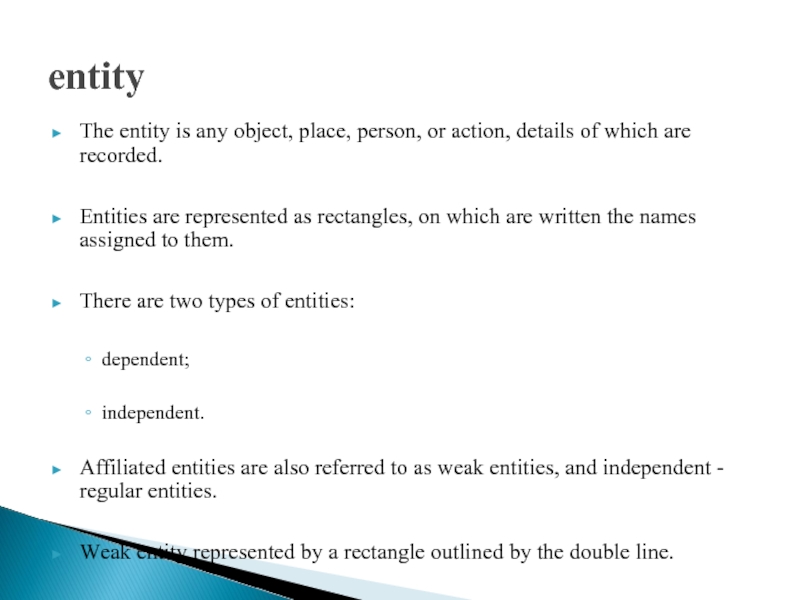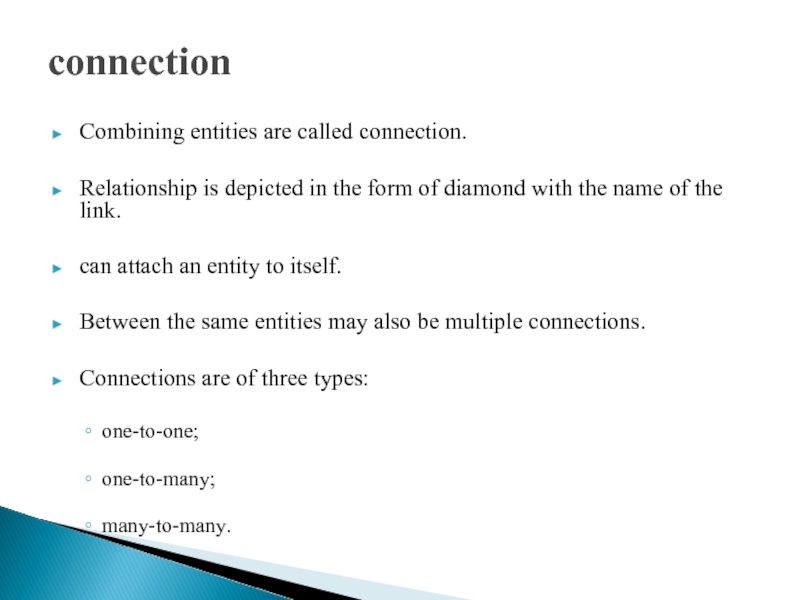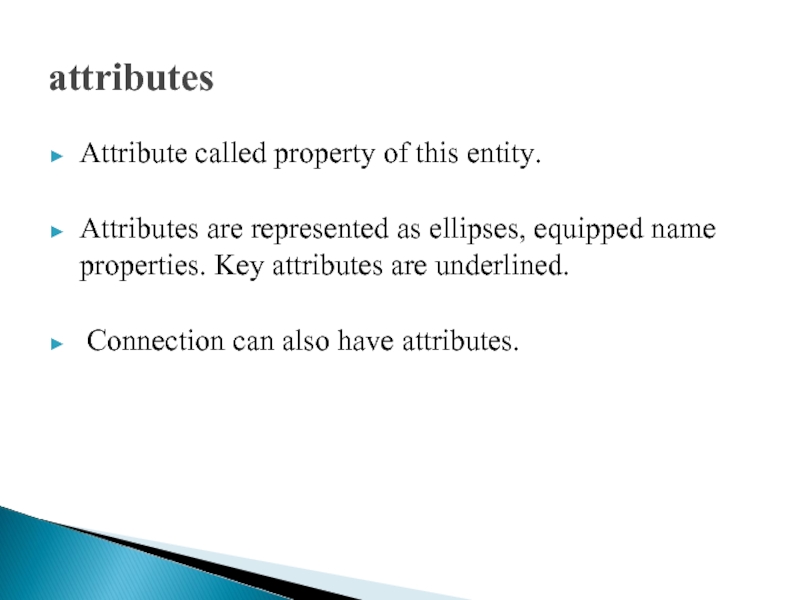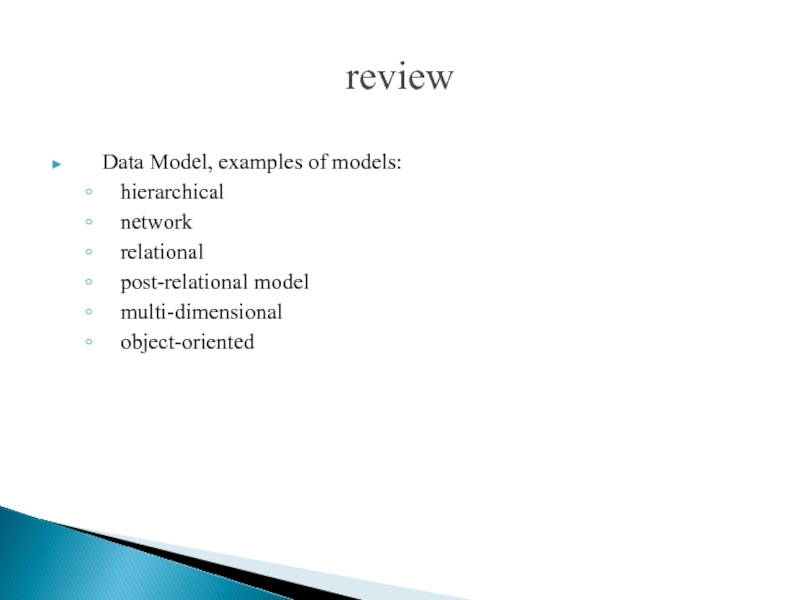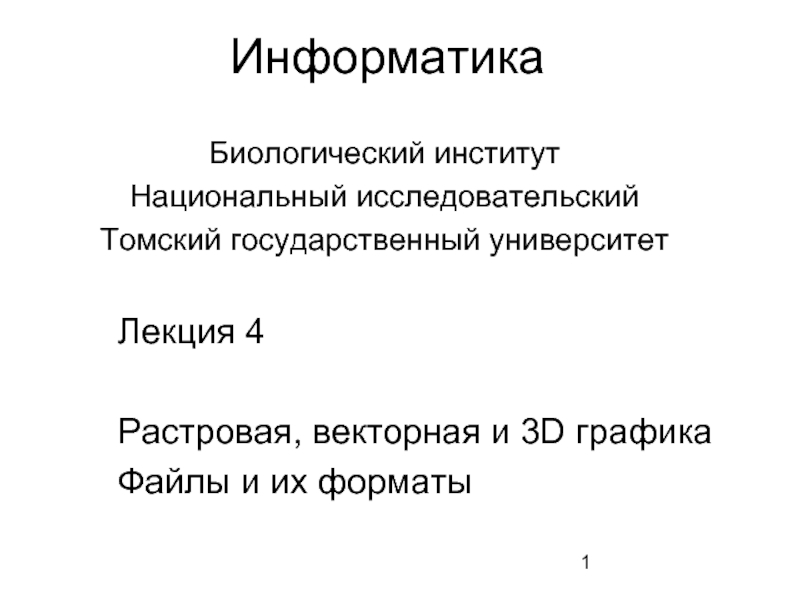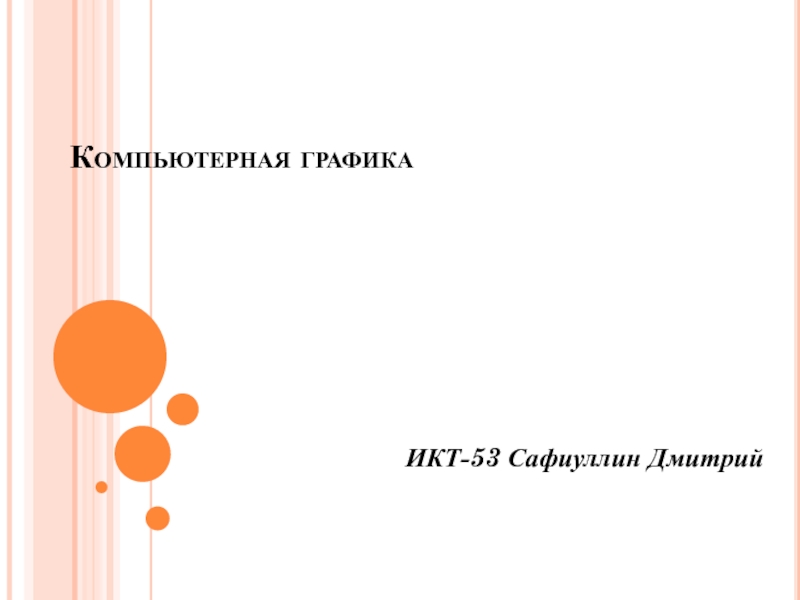- Главная
- Разное
- Дизайн
- Бизнес и предпринимательство
- Аналитика
- Образование
- Развлечения
- Красота и здоровье
- Финансы
- Государство
- Путешествия
- Спорт
- Недвижимость
- Армия
- Графика
- Культурология
- Еда и кулинария
- Лингвистика
- Английский язык
- Астрономия
- Алгебра
- Биология
- География
- Детские презентации
- Информатика
- История
- Литература
- Маркетинг
- Математика
- Медицина
- Менеджмент
- Музыка
- МХК
- Немецкий язык
- ОБЖ
- Обществознание
- Окружающий мир
- Педагогика
- Русский язык
- Технология
- Физика
- Философия
- Химия
- Шаблоны, картинки для презентаций
- Экология
- Экономика
- Юриспруденция
Data Model презентация
Содержание
- 1. Data Model
- 2. Data Model The data model is
- 3. Data Models Classic models: hierarchical
- 4. hierarchical model ADVANTAGES hierarchical model Effective
- 5. network Model ADVANTAGES network model: The
- 6. Example of a network model
- 7. relational Model ADVANTAGES relational model Simplicity,
- 8. post-relational model ADVANTAGES post-relational model The
- 9. Example of relational Model INVOICES (накладные) INVOICE.ITEMS (накладные-товары)
- 10. Example of post-relational model б) INVOICES
- 11. multivariate Model ADVANTAGES multivariate model Convenience
- 12. An example of a relational view of car sales multi-dimensional view
- 13. Object-oriented model ADVANTAGES OOM (versus relational)
- 14. Model "Entity-Relationship" There are a variety
- 15. entity The entity is any object, place,
- 16. connection Combining entities are called connection.
- 17. attributes Attribute called property of this
- 18. review Data Model, examples of models:
Слайд 1Lecture 2
Data Model
hierarchical
network
relational
post-relational
multidimensional
object-oriented
Слайд 2Data Model
The data model is a description of the organization
of data in the database.
The data model also describes the relationship between the data and restrictions applicable to the data.
Data models can be divided into two categories:
Object - a logical model - focuses on the description of data, data relationships, and limiting.
Logical model based on the entries - focuses on the description of the data structures and access methods in the database management system.
The data model also describes the relationship between the data and restrictions applicable to the data.
Data models can be divided into two categories:
Object - a logical model - focuses on the description of data, data relationships, and limiting.
Logical model based on the entries - focuses on the description of the data structures and access methods in the database management system.
Слайд 3Data Models
Classic models:
hierarchical
Network
Relational
Current models:
-post-relational
-multidimensional
-object-oriented
Other data models that extend the known models
object-relational deductive object-oriented, semantic, conceptual, and others.
object-relational deductive object-oriented, semantic, conceptual, and others.
Слайд 4hierarchical model
ADVANTAGES hierarchical model
Effective use of computer memory
Good performance of
time to perform basic operations
Model is convenient to work with hierarchically structured information
DISADVANTAGES hierarchical model Cumbersome to process information with a fairly complex logical relationships Complexity of understanding for the average user
Examples of database hierarchical model
IMS, PC / Focus, Team-Up and Data Edge, (from Russian): Ока, ИНЭС и МИРИС
DISADVANTAGES hierarchical model Cumbersome to process information with a fairly complex logical relationships Complexity of understanding for the average user
Examples of database hierarchical model
IMS, PC / Focus, Team-Up and Data Edge, (from Russian): Ока, ИНЭС и МИРИС
Слайд 5network Model
ADVANTAGES network model:
The possibility of effective implementation in terms
of memory consumption and speed
(Compared to the hierarchical) great opportunities in terms of the admissibility of arbitrary relationships education
DISADVANTAGES network model High complexity and rigidity of the database schema The difficulty for the understanding and implementation of information processing in the database as a regular user
Known network database:
IDMS, db_VistaIII,
СЕТЬ, СЕТОР и КОМПАС
DISADVANTAGES network model High complexity and rigidity of the database schema The difficulty for the understanding and implementation of information processing in the database as a regular user
Known network database:
IDMS, db_VistaIII,
СЕТЬ, СЕТОР и КОМПАС
Слайд 7relational Model
ADVANTAGES relational model
Simplicity, ease the physical implementation on a
computer
Processing efficiency
DISADVANTAGES relational model Lack of standard means of identification of individual records Complexity of the description of hierarchical and network links
Examples of relational database model:
dBaseIIIPlus и dBaseIY ( фирма Ashton-Tate), DB2(IBM), R: BASE (Microrim), FoxPro ранних версий и FoxBase (Fox Software), Paradox и dBASE for Windows (Borland), FoxPro б.поздних версий, Visual FoxPro и Access (Microsoft), Clarion (Clarion Software), Ingres (ASK Computer Systems)и Oracle (Oracle)
(from Russian): ПАЛЬМА (ИК АН УССР), HyTech (МИФИ)
Object-relational: Oracle 8.x
DISADVANTAGES relational model Lack of standard means of identification of individual records Complexity of the description of hierarchical and network links
Examples of relational database model:
dBaseIIIPlus и dBaseIY ( фирма Ashton-Tate), DB2(IBM), R: BASE (Microrim), FoxPro ранних версий и FoxBase (Fox Software), Paradox и dBASE for Windows (Borland), FoxPro б.поздних версий, Visual FoxPro и Access (Microsoft), Clarion (Clarion Software), Ingres (ASK Computer Systems)и Oracle (Oracle)
(from Russian): ПАЛЬМА (ИК АН УССР), HyTech (МИФИ)
Object-relational: Oracle 8.x
Слайд 8post-relational model
ADVANTAGES post-relational model
The possibility of representing the aggregate related
relational tables with a single post-relational table, so - clear presentation of information and increase the effectiveness of its treatment
DISADVANTAGES post-relational model The difficulty in solving the problem of ensuring the integrity and consistency of data stored
Examples of post-relational database model:
uniVers, Bubba и Dasdb
DISADVANTAGES post-relational model The difficulty in solving the problem of ensuring the integrity and consistency of data stored
Examples of post-relational database model:
uniVers, Bubba и Dasdb
Слайд 10Example of post-relational model
б) INVOICES
а) SELECT INVOICES.INVNO, CUSTNO, GOODS, QTY
FROM
INVOICES, INVOICE.ITEMS
WHERE INVOICES.INVNO=INVOICE.ITEMS.INVNO;
б) SELECT * FROM INVOICES;
WHERE INVOICES.INVNO=INVOICE.ITEMS.INVNO;
б) SELECT * FROM INVOICES;
Слайд 11multivariate Model
ADVANTAGES multivariate model
Convenience and efficiency analysis of large amounts
of data related to the time (in rel.m. - nonlinear increase complexity of operations)
DISADVANTAGES multivariate model Cumbersome for the simplest of tasks common operational processing
EXAMPLES database multidimensional model
Essbase (Arbor Software), Media Multi-matrix (Speedware), Oracle Express Server (Oracle) и Cache (InterSystems)
Relational-dimensional model: Media/MR (Speedware)
Multidimensional object-relational model: Cache
DISADVANTAGES multivariate model Cumbersome for the simplest of tasks common operational processing
EXAMPLES database multidimensional model
Essbase (Arbor Software), Media Multi-matrix (Speedware), Oracle Express Server (Oracle) и Cache (InterSystems)
Relational-dimensional model: Media/MR (Speedware)
Multidimensional object-relational model: Cache
Слайд 13Object-oriented model
ADVANTAGES OOM (versus relational)
The ability to display information about
the complex relationships of objects
OOM can identify individual records database and the responsibilities of their treatment
DISADVANTAGES OOM High conceptual complexity The disadvantage of the data and the low speed of queries
EXAMPLES database OOM
POET (POET Software), Jasmine (Computer Associates), Versant (Versant Technologies), 02 (Ardent Software), ODB-Jupiter (науч.произв. центр «ИнтеллекПлюс»), Iris, Orion и Postgres.
DISADVANTAGES OOM High conceptual complexity The disadvantage of the data and the low speed of queries
EXAMPLES database OOM
POET (POET Software), Jasmine (Computer Associates), Versant (Versant Technologies), 02 (Ardent Software), ODB-Jupiter (науч.произв. центр «ИнтеллекПлюс»), Iris, Orion и Postgres.
Слайд 14Model "Entity-Relationship"
There are a variety of object-oriented models. The most
widely used model is the "entity - relationship" (ER model).
Model "entity - relationship" is based on a realistic view which encompasses a set of objects or entities and their relationships.
Schema components of ER are:
entity ;
connection;
attributes.
Model "entity - relationship" is based on a realistic view which encompasses a set of objects or entities and their relationships.
Schema components of ER are:
entity ;
connection;
attributes.
Слайд 15entity
The entity is any object, place, person, or action, details of
which are recorded.
Entities are represented as rectangles, on which are written the names assigned to them.
There are two types of entities:
dependent;
independent.
Affiliated entities are also referred to as weak entities, and independent - regular entities.
Weak entity represented by a rectangle outlined by the double line.
Entities are represented as rectangles, on which are written the names assigned to them.
There are two types of entities:
dependent;
independent.
Affiliated entities are also referred to as weak entities, and independent - regular entities.
Weak entity represented by a rectangle outlined by the double line.
Слайд 16connection
Combining entities are called connection.
Relationship is depicted in the form
of diamond with the name of the link.
can attach an entity to itself.
Between the same entities may also be multiple connections.
Connections are of three types:
one-to-one;
one-to-many;
many-to-many.
can attach an entity to itself.
Between the same entities may also be multiple connections.
Connections are of three types:
one-to-one;
one-to-many;
many-to-many.
Слайд 17attributes
Attribute called property of this entity.
Attributes are represented as ellipses,
equipped name properties. Key attributes are underlined.
Connection can also have attributes.
Connection can also have attributes.
